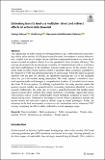| dc.contributor.author | Sabouri, Sadegh | |
| dc.contributor.author | Ewing, Reid | |
| dc.contributor.author | Kalantari, Hannaneh A. | |
| dc.date.accessioned | 2024-10-24T20:15:50Z | |
| dc.date.available | 2024-10-24T20:15:50Z | |
| dc.date.issued | 2024-10-17 | |
| dc.identifier.uri | https://hdl.handle.net/1721.1/157413 | |
| dc.description.abstract | The significance of public transit in curbing greenhouse gas (GHG) emissions and reducing vehicle miles traveled (VMT) goes beyond its users. Investments in transit infrastructure, coupled with service enhancements and their consequential impacts on urban development (termed as indirect effects), have the potential to foster location efficiency. This concept encompasses the advantageous proximity of vital destinations such as workplaces and retail establishments to the residences that necessitate access. In this context, investments made in public transit systems exhibit a multiplier effect, commonly quantified as the reduction in VMT per each passenger mile of transit usage. While this topic has gained attention over the past few decades, an agreement regarding the size of the multiplier effect has yet to be reached among researchers. This study employs a multilevel structural equation model and leverages a comprehensive database of household travel survey data from 31 diverse regions. By utilizing trip-level data, this study provides results that possess external validity and generalizability, overcoming limitations identified in earlier research. Additionally, this study aims to present a simplified formula that enables transit agencies nationwide to compute their unique multipliers. The findings suggest that regions with extensive transit systems exhibit higher transit multipliers compared to regions with limited transit access. Furthermore, the impact of transit within a community extends well beyond merely the reduction in private vehicle usage by transit passengers. Rather, the alterations in the built environment in transit-served communities lead to substantial VMT savings, surpassing the effects solely attributed to transit passenger usage. | en_US |
| dc.publisher | Springer US | en_US |
| dc.relation.isversionof | https://doi.org/10.1007/s11116-024-10542-0 | en_US |
| dc.rights | Creative Commons Attribution | en_US |
| dc.rights.uri | https://creativecommons.org/licenses/by/4.0/ | en_US |
| dc.source | Springer US | en_US |
| dc.title | Estimating transit’s land-use multiplier: direct and indirect effects on vehicle miles traveled | en_US |
| dc.type | Article | en_US |
| dc.identifier.citation | Sabouri, S., Ewing, R. & Kalantari, H.A. Estimating transit’s land-use multiplier: direct and indirect effects on vehicle miles traveled. Transportation (2024). | en_US |
| dc.contributor.department | Massachusetts Institute of Technology. Department of Urban Studies and Planning | en_US |
| dc.relation.journal | Transportation | en_US |
| dc.identifier.mitlicense | PUBLISHER_CC | |
| dc.eprint.version | Final published version | en_US |
| dc.type.uri | http://purl.org/eprint/type/JournalArticle | en_US |
| eprint.status | http://purl.org/eprint/status/PeerReviewed | en_US |
| dc.date.updated | 2024-10-20T03:22:33Z | |
| dc.language.rfc3066 | en | |
| dc.rights.holder | The Author(s) | |
| dspace.embargo.terms | N | |
| dspace.date.submission | 2024-10-20T03:22:33Z | |
| mit.license | PUBLISHER_CC | |
| mit.metadata.status | Authority Work and Publication Information Needed | en_US |
